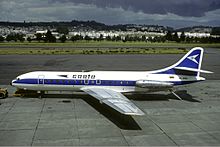| This article needs additional citations for verification. Please help improve this article by adding citations to reliable sources. Unsourced material may be challenged and removed. Find sources: "SAETA" – news · newspapers · books · scholar · JSTOR (October 2009) (Learn how and when to remove this message) |
| |||||||
| Founded | 1966 | ||||||
|---|---|---|---|---|---|---|---|
| Ceased operations | February 2000 | ||||||
| Hubs | Old Mariscal Sucre International Airport | ||||||
| Secondary hubs | José Joaquín de Olmedo International Airport | ||||||
| Frequent-flyer program | ADDmiles | ||||||
| Subsidiaries | SAN Ecuador | ||||||
| Fleet size | 7 | ||||||
| Destinations | 19 | ||||||
| Headquarters | Quito, Ecuador | ||||||
| Website | www | ||||||
SAETA Air Ecuador (legally Sociedad Anónima Ecuatoriana de Transportes Aéreos S.A.) was a privately held airline of Ecuador, which was founded in 1966. During its heyday in the 1990s, it flew to numerous destinations in North and South America from its base in Guayaquil.
History

SAETA was founded in Quito in 1966, later the company headquarters were relocated to Guayaquil. The main owners were the Dunn family.
In addition to domestic flights, SAETA operated routes in North, Central and South America. It preferred flights to Los Angeles, New York City, Miami, Panama City, Caracas, Bogotá, Lima, Santiago and Buenos Aires.
In 1990, SAETA took over the Ecuadorian airline SAN, increasing frequencies and fleet for national and international flights. The airline later in 1994 took over LAPSA from Paraguay, operated with an Ecuadorian-Paraguayan Consortium until being sold to TAM Linhas Aereas in 1996. Political instability in the country and currency devaluation led to a decline in passenger numbers. This was followed by the cancellation of flights to the United States of America due to the loss of the approach permit for Category 1 airports.
By the mid-1990s, events such as political instability and the devaluation of the currency, damaged SAETA, which caused a reduction in passengers, added to the cancellation of flights to the United States due to the loss of category 1 of the Ecuadorian aeronautical authority since 1993, accelerating its decline. Both SAN and SAETA had serious security breaches, which resulted in the loss of several flights.
In February 2000, SAETA ended its flight operations after severe financial problems following the 1998–1999 Ecuador economic crisis.
Destinations


 Argentina
Argentina
 Bolivia
Bolivia
 Brazil
Brazil
 Chile
Chile
 Colombia
Colombia
 Dominican Republic
Dominican Republic
 Ecuador
Ecuador
 Panama
Panama
 Peru
Peru
 United States
United States
 Venezuela
Venezuela
Fleet

SAETA had operated the following aircraft since it commenced operations:
| Aircraft | Total | Introduced | Retired | Notes |
|---|---|---|---|---|
| Airbus A310-300 | 2 | 1992 | 1996 | |
| Airbus A320-200 | 4 | 1994 | 1999 | |
| Boeing 707-320C | 1 | 1985 | 1993 | |
| Boeing 727-100 | 2 | 1981 | 2000 | |
| Boeing 727-200 | 3 | 1991 | 2000 | |
| Boeing 737-200 | 1 | 1994 | 1995 | |
| Boeing 737-300 | 2 | 1994 | 2000 | |
| Douglas C-47 Skytrain | 3 | 1967 | 1976 | |
| Sud Aviation Caravelle | 4 | 1975 | 1986 | |
| Vickers Viscount 700 | 4 | 1969 | 1980 |
Accidents and incidents
- On July 3, 1969, a Douglas C-47 was hijacked on a domestic flight from Tulcán Airport to Mariscal Sucre International Airport. The hijackers demanded to be taken to Cuba.
- On October 20, 1971, a Vickers Viscount was hijacked by six people. It landed at Mariscal Lamar International Airport.
- On August 15, 1976, SAETA Flight 232, a Vickers Viscount (registered HC-ARS) crashed into the Chimborazo volcano, killing all 59 people on board. The flight was considered missing until February 2003, after an independent verification of aircraft wreckage that was discovered in October 2002.
- On April 23, 1979, a Vickers Viscount (registered HC-AVP) crashed in the Pastaza Province on a flight between the Quito and Cuenca, killing all 57 people on board. The flight was considered missing until 1984, when the wreckage was discovered. The aircraft was 25 nautical miles (46 km) off track.
- On January 18, 1986, a Sud Aviation Caravelle (registered HC-BAE), operated by Aerovías, crashed in a jungle area after executing a second missed approach procedure at Flores International Airport. Low lying clouds in the area forced the crew to carry out the missed approaches. All 88 passengers and 6 crew members died in the accident.
- On August 22, 1997, a Boeing 727-200 (registered HC-BVU) was landing at San Cristóbal Airport when its undercarriage struck the raised lip of the runway, causing it to collapse. It slid for about 700 m before coming to rest on the right side of the runway.
See also
References
- http://www.saeta.com.ec SAETA Page
- "SAETA fleet". aerobernie.bplaced.net. Retrieved February 20, 2021.
- Ulrich Klee, Frank Bucher et al.: jp airline-fleets international. Zürich-Airport 1960–2000.
- "Hijacking Description". Aviation Safety Network. Retrieved 14 February 2011.
- "Accident description". Aviation Safety Network. Retrieved September 5, 2009.
- "Accident description". Aviation Safety Network. Retrieved November 2, 2010.
- "Accident description". Aviation Safety Network. Retrieved September 5, 2009.
- "Accident description". Aviation Safety Network. Retrieved January 12, 2021.
- "Accident description". Aviation Safety Network. Retrieved September 5, 2009.
External links
Portals:| Passenger | |
|---|---|
| Cargo | |
| Defunct | |